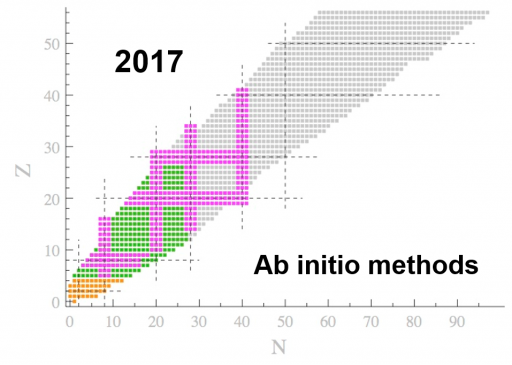
Ab initio evolution of the nuclear chart, status in 2017, with the area covered by the various methods: “exact” approaches for lightest nuclei (Monte Carlo, ..) [orange; since 1980’s]; from closed-shell with SCGF, CC, IMSRG to open-shell nuclei using GGF, BCC, MR- IMSRG [pink, since 2010-2013]; ab initio shell model with effective interaction via CC IMSRG [green, since 2014].
SCGF: Self consistent Green Function; IM SRG, In medium similarity renormalization group; MR SRG, multireference SRG.
The theoretical activity of DPhN in low-energy nuclear physics concerns the development of many-body methods and their application to the description of atomic nuclei. The main focus is on so-called ab initio (i.e. “from first principles”) approaches, which aim at a description of A-nucleon systems in terms of basic interactions between protons and neutrons. In this context, the two main difficulties resides in the modelling of the nuclear interactions themselves and in the solution of a complicated many-body problem, typically expressed in the form of a static A-body Schrödinger equation. Modern numerical codes and computational resources give access to an (almost) exact solution of the problem, yet only for very light nuclei (A<12). Applications to medium-mass and heavy nuclei require the introduction of approximation techniques that warrant a gentle scaling with the number of nucleons.
The development of such techniques is at the heart of the theoretical research conducted at DPhN. In strong interaction with these activities, working groups are organized each year within the framework of the virtual laboratory for Theory in Nuclear Structure and reactions, ESNT.
More specifically, the DPhN group has devised generalisations of standard ab initio techniques to open-shell nuclei, i.e. nuclei that can not be, even qualitatively, represented by sets of completely filled nucleonic shells. The open-shell character is associated with the onset of nuclear superfluidity and deformation, which necessarily complicate the theoretical description and make standard methods inapplicable. The key ingredient of the generalised methods is the concept of symmetry breaking and restoration, which powerfully allows to grasp correlations related to superfluidity and deformation (static correlations) consistently with correlations already present in closed-shell nuclei (dynamical correlations). The resulting approaches fall under the name of self-consistent Gorkov-Green functions (SCGGF) [1], (symmetry-restored [3]) Bogolyubov coupled cluster method (BCC) [2] or (symmetry-restored [3]) Bogolyubov many-body perturbation theory [4]. The associated numerical codes are exploited on high-performance computing machines, e.g at the Très Grand Centre de Calcul (TGCC) of CEA. The methods are routinely applied to cases of experimental interest [2] in the medium-mass sector (from mass 10 to mass 100) of the nuclear chart, in primis to those studied by the experimental groups at DPhN. By means of their confrontation with (new) experimental data, these innovative many-body methods allow us both to probe new facets of the atomic nucleus and to test modern modeling of nuclear interactions in regions of the nuclear chart so far inaccessible to such theoretical predictions [5-9].
Another area of theoretical work relates to a more effective approach to nuclear structure, so-called energy density functionals. The strategy here is to trade the direct link with underlying basic interactions, i.e. to make use of some effective or “in-medium” nucleon-nucleon interaction, for a more easily solvable many-body problem. This results in a method that scales even more gently with mass number and is thus applicable to the whole nuclear chart, at the price of including some phenomenological ingredients. The activity at DPhN builds on the long tradition that these techniques have at CEA Saclay and at the same time works towards their modernisation [3], namely by improving their systematic character and predictive power [10].
References:
[1] V. Somà, T. Duguet, C. Barbieri, "Ab-initio self-consistent Gorkov-Green's function calculations of semi-magic nuclei. I. Formalism at second order with a two-nucleon interaction", Phys. Rev. C 84 (2011) 064317.
[2] A. Signoracci, T. Duguet, G. Hagen, G. R. Jansen, "Ab-initio Bogoliubov coupled cluster theory for open-shell nuclei", Phys. Rev. C 91 (2015) 064320.
[3] T. Duguet, "Symmetry broken and restored coupled-cluster theory. I. Rotational symmetry and angular momentum", J. Phys. G: Nucl. Part. Phys. 42 (2015) 025107; T. Duguet, A. Signoracci, "Symmetry broken and restored coupled-cluster theory. II. Global gauge symmetry and particle number", J. Phys. G: Nucl. Part. Phys. 44 (2016) 015103.
[4] P. Arthuis, A. Tichai, J.-P. Ebran, R. Roth, T. Duguet, "Bogoliubov many-body perturbation theory for open-shell nuclei", to be published.
[5] V. Somà, A. Cipollone, C. Barbieri, P. Navràtil, T. Duguet, "Leading chiral three-nucleon forces along isotope chains in the calcium region", Phys. Rev. C 89 (2014) 061301.
[6] T. Duguet, H. Hergert, J.D. Holt, V. Somà, “Non observable nature of the nuclear shell structure: Meaning, illustrations, and consequences”, Phys.Rev. C 92 (2015) 034313.
[7] M.Rosenbusch, et al. (V.Somà), “Probing the N=32 Shell Closure below the Magic Proton Number Z=20: Mass Measurements of the Exotic Isotopes 52, 53K”, Phys. Rev. Lett. 114 (2015) 202501.
[8] V. Lapoux, V. Somà, C. Barbieri, H. Hergert, J.D. Holt, S.R. Stroberg, "Radii and binding energies in oxygen isotopes: a puzzle for nuclear forces", Phys. Rev. Lett. 117 (2016) 052501.
[9] T. Duguet, V. Somà, S. Lecluse, C. Barbieri, P. Navràtil, "Ab initio calculation of the potential bubble nucleus 34Si", Phys. Rev. C 95 (2017) 034319.
[10] T. Duguet, M. Bender, J.-P. Ebran, T. Lesinski, V. Somà, “Ab initio-driven nuclear energy density functional method - A proposal for safe/correlated/improvable parametrizations of the off-diagonal EDF kernels”, Eur. Phys. J. A 51 (2015) 162.
Contacts : Th. Duguet, V. Somà



